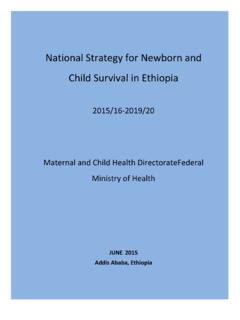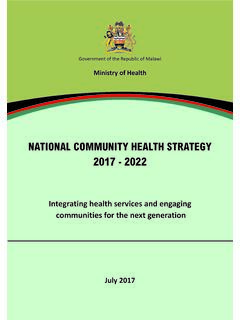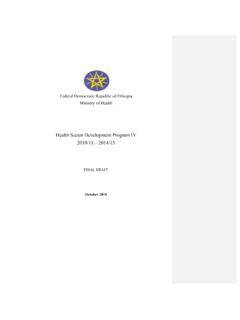Transcription of Infection Prevention and Control at Neonatal Intensive ...
1 Infection Prevention and Control at Neonatal Intensive Care Units Adapting this presentation Adapt based on the country context Personalize with local photos. Consider adding country or regional-level data as comparison slides. Add suitable local examples of Infection Prevention and Control program experiences Add local data and initiatives on antimicrobial resistance Suggested citation: Gaurav Sharma, Nabila Zaka and Tedbabe Hailegebriel; Infection Prevention Control at Neonatal Intensive Care Units; UNICEF, New York (2018). List of references provided at the end for further reading Course Outline Background: Definition, Aetiology, burden, common pathogens- bacterial and viral Types of Health Care Associated infections Infection Prevention and Control : Overview, Guidelines, WASH and IPC.
2 Antimicrobial Resistance Effective interventions for reducing infections at the time of birth General Infection Prevention and Control for all newborns Prevention of infections in neonates requiring special care Spacing requirements Water supply and use Handling infant feeds Hand Hygiene Family Centred Care Isolation and Cohorting Improving IPC targets through QI projects UNICEF/UN0205733/Njiokiktjien VII Photo Summary Discussion Have you heard of the term Healthcare Associated infections ? Is it important at your workplace? Why is it important in neonates? Definition of Healthcare Associated Infection (HAI). Infection that occurs in a patient as a result of care received at a health facility and was not present at the time of arrival at the facility.
3 HAI starts on or after the 3rd day of admission to the health facility (Day of admission is Day 1) or on the day of or the day after discharge from the facility. Replaces the formerly used nosocomial or hospital Infection because evidence has shown that these infections can affect patients in any setting where they receive health care. Definition of Healthcare Associated infections in newborns Infection of the newborn that occurs after birth in a health care facility. Timeframes between 72 hours and 7. days are often used. infections occurring on the day of birth/admission or the day after are not health care-associated infections . Aetiology of infections amongst newborns Source Microorganisms Across the placenta Treponema pallidum, cytomegalovirus, rubella, varicella (chicken pox), Toxoplasmosis gondii, HIV.
4 Mother's birth canal group B streptococci, E. coli, Coagulase-negative staphylococcus, Listeria monocytogenes, HBV, HIV, HSV. Environment within Gram-negative organisms ( , Klebsiella pneumoniae) often health care facility multidrug resistant (MDR), opportunistic infections ( , coagulase- negative Staphylococcus spp.), Gram positive organisms ( , MRSA), respiratory viruses, and gastrointestinal infections ( , Staphylococcus spp.). Risk factors for Neonatal infections newborn risk factors that Lower birth weight (ELBW>VLBW). increase the risk of Younger gestational age Infection Immunology of the neonate: Immunocompromised, immature, ineffective and inadequate levels of antibodies Co-morbidities ( : congenital conditions). Care-related risk factors Intensive care stay that increase the risk of Presence of invasive medical devices Infection Parenteral nutrition Antimicrobial therapy which may lead to multiple drug resistance organism (MDRO) infections Overcrowding and Understaffing Ward layout (sinks, bed spacing).
5 Use of foetal scalp electrodes/ probes and canula Contact with colonized/ infected family, visitors, or healthcare workers Proximity of colonized neonates. Increased length of stay Rates of healthcare-acquired infections (HAI) in newborns are 20 times higher in resource-limited settings compared to developed country context, with inadequate environmental hygiene and low adherence to Infection Prevention and Control cited as potential explanations (Allengranzi et al, 2011). Contributing Factors for Healthcare Associated infections High patient-to-nurse ratio Increasing use of invasive medical devices ( , mechanical ventilators, central intravenous lines). Bed space less than 1 meter (3 feet) apart Inadvertent contamination of prepared Low compliance with hand hygiene practices supplies/pharmaceuticals ( , IV fluid, infant formula, Limited resources for isolation or cohorting (grouping general medications).)
6 Babies with the same condition together) Suboptimal cleaning, disinfection, and sterilization practices Lack of trained IPC practitioners and limited opportunities Antibiotic resistance due to overuse of broad-spectrum for staff training antibiotics Increasing use of complex medical and surgical procedures Ref: Allegranzi et al. 2011. Discussion What are the most What is the burden of frequent types of Healthcare Associated infections in Neonatal infections in NICUs? Intensive Care Units? Burden of Healthcare Associated infections Variations in definitions and reporting mean that exact global burden of HAIs is difficult to quantify Higher incidence in NICUs than other ICUs because of unique vulnerabilities of neonates and environmental risk factors specific to NICUs United States of America: million annually, causing approximately 99,000 deaths and severe morbidity (Klevens 2007; Stone 2009; Hooven 2014).
7 33,000 infants are diagnosed with HAI each year in NICUs (Klevens 2007). Types of HAIs in NICUs (Polin 2012; Hooven 2014). Central line-associated bloodstream infections (CLABSI). Pneumonia infections of the skin and soft tissues, urinary tract and the central nervous system Source: Getty images Burden of HAI Southeast Asia Overall prevalence 9% ( ). Incidence density: 20 per 1000 ICU days Associated mortality Excess Length of stay: 5-21 days Types of Infection Source: UNICEF, UN0188843. Central Line Associated Blood Stream infections catheter days (95%CI: ). Ventilator Associated Pneumonia ventilator days (95% CI: ). Catheter Associated Urinary Tract Infection catheter days (95% CI: ). Surgical Site Infection (95% CI: ). Source: Ling ML.
8 The burden of healthcare-associated infections in Southeast Asia: a systematic literature review and meta-analysis. Clinical Infectious Diseases. 2015 Feb 12;60(11):1690-9. Neonatal Sepsis in Low and Middle Income Countries (LMIC). Hospital-born babies in LMICs are at risk of infections given poor Infection - Control practices. Neonatal sepsis could be early or late onset. Major pathogens: Klebsiella pneumoniae, Escherichia coli, Pseudomonas spp, Acinetobacter spp and Staphylococcus aureus About 70% resistant to ampicillin and gentamicin and many might be untreatable Associated with high mortality, morbidity and treatment costs which pose as barriers to improving health seeking behaviour Low-cost, bundled interventions using systems quality improvement approaches for improved Infection Control are needed.
9 Zaidi, Anita KM, et al. The Lancet (2005): 1175-1188. Common pathogens causing Neonatal infections Bacterial infections Viral infections group B streptococcus Hepatitis B. Staphylococcus aureus Hepatitis C. Chlamydia Herpes simplex virus Gonorrhoea Human immunodeficiency virus Listeriosis Human papilloma virus Tetanus Influenza virus Syphilis Rubella Varicella group B streptococcus Gram + bacterium, causes invasive disease primarily in infants and pregnant or postpartum women. Major cause of newborn meningitis and septicaemia (Gray et al. 2011). Early-onset GBS disease (within first 6 days)- maternally acquired. Women with diabetes are more likely to be colonized with GBS (AAP. 2012). Late-onset GBS disease (7 days to 89 days) is considered to be an HAI.
10 Symptoms and signs: Respiratory distress, apnoea, or other signs of Image credit: James Archer / CDC. sepsis, mostly characterized by pneumonia and sepsis. Screening for group B streptococcus - 1. Risk factor based: If the woman has one of the following intrapartum risk factors, intravenous antibiotic prophylaxis is indicated: Childbirth at less than 37 weeks' gestation Amniotic membrane rupture for 18 or more hours Intrapartum temperature of at or above 38 C ( F). Culture-based screening: Based on a positive vaginal-rectal swab, obtained at 35 37 weeks of gestation and cultured for GBS. Best practice: Screen all pregnant women for GBS when in labour and provide intrapartum antibiotic prophylaxis at the onset of active labour for those who have a positive GBS culture.











